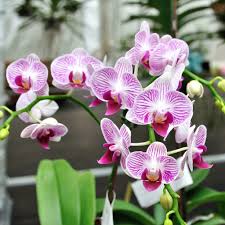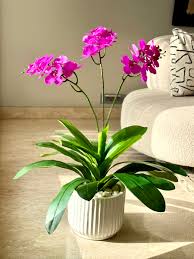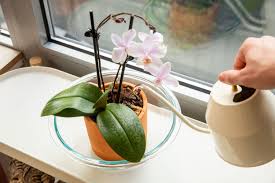Orchids are known for their exotic beauty and elegant blooms. Despite their reputation for being high-maintenance, many varieties of orchids are surprisingly easy to care for — especially when you understand their needs. This guide will walk you through everything you need to know about planting and growing orchids at home, from selecting the right variety to maintaining ideal conditions and troubleshooting common issues.

Summary Table
| Aspect | Details |
|---|---|
| Best Orchid Types for Beginners | Phalaenopsis, Dendrobium, Cattleya, Oncidium |
| Ideal Light | Bright, indirect sunlight |
| Ideal Temperature | Day: 65–80°F (18–27°C); Night: 55–65°F (13–18°C) |
| Humidity Requirement | 50–70% (can use a humidity tray or humidifier) |
| Watering Frequency | Once a week in winter, twice a week in summer |
| Fertilization | Every 2–3 weeks during the growing season |
| Repotting Interval | Every 1–2 years |
| Common Issues | Yellowing leaves, wrinkling, moldy roots, lack of blooms |
| Official Resource | South African Orchid Council |
Choosing the Right Orchid Variety

Not all orchids are created equal. Some are ideal for beginners, while others require more advanced care. Here are some beginner-friendly varieties:
1. Phalaenopsis (Moth Orchid)
-
One of the most common houseplant orchids.
-
Blooms last several weeks in a wide range of colors.
-
Thrives in indirect light with stable humidity.
2. Dendrobium
-
Compact and manageable in size.
-
Tolerant to varied conditions.
-
Blooms can last up to six weeks.
3. Cattleya
-
Noted for their large, fragrant flowers.
-
Prefers bright, filtered light and requires slightly more humidity control.
4. Oncidium (Dancing Lady Orchid)
-
Known for flowers that resemble dancing figures.
-
Thrives in bright, filtered light with regular watering.
Creating the Ideal Environment
Orchids naturally grow in tropical climates, so mimicking those conditions at home is key to their success.
Light
-
Provide bright, indirect sunlight.
-
Avoid placing orchids in direct sun to prevent leaf scorching.
-
Best locations: north or east-facing windows.
Temperature
-
Daytime: 65–80°F (18–27°C)
-
Nighttime: 55–65°F (13–18°C)
-
Avoid cold drafts or placing near heating vents.
Humidity
-
Maintain 50–70% humidity.
-
Use tools like a humidity tray, room humidifier, or daily misting.
Air Circulation
-
Good airflow prevents fungal issues.
-
Ensure the plant is in a location with soft, circulating air.
What You’ll Need to Grow Orchids

Before planting, gather these essentials:
-
Healthy orchid plant or seedling
-
Orchid pot with drainage holes
-
Orchid-specific growing medium (e.g., bark chips, sphagnum moss)
-
Humidity tray (optional)
-
Watering can or spray bottle
-
Balanced fertilizer (20-20-20 or orchid-specific)
Step-by-Step Guide to Planting Orchids at Home
Step 1: Select a Pot and Medium
-
Use a pot with extra drainage holes.
-
Growing medium should provide both drainage and airflow—avoid regular soil.
Step 2: Prepare the Plant
-
Carefully remove the orchid from its old pot.
-
Trim dead or rotting roots using sterilized scissors.
-
Rinse healthy roots with lukewarm water.
Step 3: Pot the Orchid
-
Add a layer of medium to the pot base.
-
Place the orchid inside, spreading the roots out gently.
-
Fill in around the roots without burying the crown of the plant.
Step 4: Water Thoroughly
-
Water until the medium is evenly moist.
-
Let excess water drain fully to prevent root rot.
Step 5: Choose the Right Location
-
Place the orchid near an east-facing window.
-
Avoid strong afternoon sun exposure.
Caring for Orchids: Weekly Routine

Consistency is the key to thriving orchids.
Watering
-
Water once per week in cooler months, twice in warmer seasons.
-
Let the growing medium dry slightly between watering.
-
Use room-temperature, filtered water for best results.
Humidity Control
-
Use a pebble tray under the pot with water.
-
Mist the orchid leaves in the morning.
Fertilizing
-
Feed with a balanced orchid fertilizer every 2–3 weeks during spring and summer.
-
Reduce or stop fertilizing in autumn and winter.
Repotting
-
Repot every 1–2 years or when the medium breaks down.
-
Best time: after flowering.
Common Problems and Fixes
| Problem | Cause | Solution |
|---|---|---|
| Yellow leaves | Overwatering or poor drainage | Water less often and improve drainage |
| Wrinkled leaves | Underwatering or root rot | Inspect roots and adjust watering |
| No blooms | Lack of light or nutrients | Move to a brighter spot and fertilize |
| Moldy roots/medium | Excess moisture or poor air circulation | Repot with fresh medium and improve airflow |
| Drooping flowers | Sudden temperature change | Keep temperatures stable |
Tips to Encourage More Blooms
-
Provide bright, indirect sunlight.
-
Ensure a 10°F temperature drop between day and night.
-
Use a bloom booster fertilizer when flower buds appear.
-
After flowers drop, trim the spike above a node to encourage reblooming (especially for Phalaenopsis).
Benefits of Growing Orchids at Home
-
Enhances indoor air quality.
-
Adds elegance and color to interior spaces.
-
Provides a soothing and meditative gardening experience.
-
Makes for meaningful gifts for loved ones.
-
Low maintenance once established.
Frequently Asked Questions
Q: How long do orchid flowers typically last?
A: Orchid blooms usually last between 6 and 10 weeks, depending on the variety and care conditions.
Q: Should I repot my orchid often?
A: Orchids prefer to be snug in their pots. Repot only every 1–2 years, or when the medium decomposes.
Q: Can I use regular potting soil for orchids?
A: No. Regular soil retains too much water and may cause root rot. Use a special orchid mix.
Q: How do I know when it’s time to water my orchid?
A: Check the growing medium. If it feels dry an inch below the surface, it’s time to water.
Q: Why aren’t my orchids blooming?
A: This could be due to low light, improper temperature, or lack of nutrients.
Final Thoughts
Orchids are often misunderstood as difficult houseplants, but the truth is, with the right setup and regular attention, they are remarkably forgiving and deeply rewarding. Whether you’re just getting started or looking to add new varieties to your collection, following these tips will help you maintain vibrant, healthy orchids that bloom year after year.
Official Resource:
Visit the South African Orchid Council for more tips, resources, and events.
Click here to know more